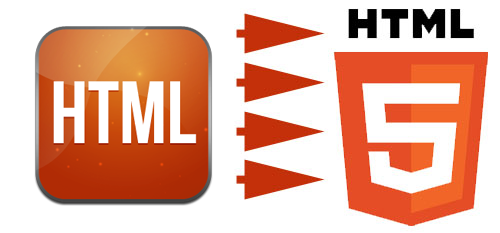HTML vs HTML5
HTML was originally developed by Tim Berners-Lee while at CERN. While working at CERN, he became frustrated at having to log on to different computers to find different information and thought that there must be a better way. He figured that there must be a way to hop from one set of information to another that's on different computers. This concept of a hypertext system (connected with the networking technology and protocols needed to pass information between computers) would go on to form the basis for the fundamental language of the world wide web HTML.
HTML is a markup language used to create Web pages. A markup language provides a way to describe the structure of text and graphics on a web page. HTML standard were and are created by World Wide Web consortium (W3C). It is derived from a more general markup language called Standard Generalized Markup Language (SGML), which is an International Organization for Standardization (ISO) technology that defines markup languages.

HTML5 is markup language for structuring and presenting content for the World Wide Web, and is a core technology of the Internet originally proposed by Opera Software .It is the fifth revision of the HTML standard (created in 1990 and standardized as HTML4 as of 1997) and, as of August 2012, is still under development.
Its core aims have been to improve the language with support for the latest multimedia while keeping it easily readable by humans and consistently understood by computers and devices (web browsers, parsers, etc.). HTML5 is a cooperation between the World Wide Web Consortium (W3C) and the Web Hypertext Application Technology Working Group (WHATWG).WHATWG was working with web forms and applications, and W3C was working with XHTML 2.0. In 2006, they decided to cooperate and create a new version of HTML.
Difference between HTML and HTML5:
HTML
DOCTYPE is much longer as HTML4 is based on SGML-based.
< DOCTYPE HTML PUBLIC "-//W3C//DTD HTML 4.01//EN" >
http://www.w3.org/TR/html4/strict.dtd"
Audio and Video are not part of HTML4 specification.
Vector Graphics is possible with the help of technologies such as VML, Silverlight, Flash etc
It is almost impossible to get true GeoLocation of user
browsing any website especially if it comes to mobile devices.
Browser cache can be used as temporary storage.
Web Sockets are not available. Generally used
mechanisms are long polling and streaming.
Does not allow JavaScript to run in browser. JS runs in
same thread as browser interface.
Works with all old browsers
HTML5
DOCTYPE is required to enable standards mode
for HTML documents.
< DOCTYPE html>
Audio and Videos are integral part of HTML5
specifications e.g. < audio> and< video> tags.
Vector graphics is integral part of HTML5 e.g.SVG and canvas
JS GeoLocation API in HTML5 helps identify
location of user browsing any website (provided user allows it)
Application Cache, Web SQL database and Web
storage is available as client side storage. Accessible using JavaScript interface in HTML5 compliant browsers.
Full duplex communication channels can be
established with Server using Web Sockets. Accessible using JavaScript interface in HTML5
compliant browsers.
Allows JavaScript to run in background. This is possible due to JS Web worker API in HTML5
Most of modern browser have started supporting HTML5 specification e.g. Firefox, Mozilla, Opera, Chrome, Safari etc.

